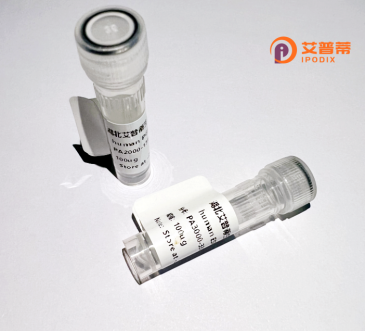
| 纯度 | >90%SDS-PAGE. |
| 种属 | Human |
| 靶点 | EPPB9 |
| Uniprot No | 0 |
| 内毒素 | < 0.01EU/μg |
| 表达宿主 | E.coli |
| 表达区间 | 1-153aa |
| 氨基酸序列 | MATASPSVFLLMVNGQVESAQFPEYDDLYCKYCFVYGQDWAPTAGLEEGISQITSKSQDVRQALVWNFPIDVTFKSTNPYGWPQIVLSVYGPDVFGNDVVRGYGAVHVPFSPGRHKRTIPMFVPESTSKLQKFTSLCLVASSDLQAAPPTEDK |
| 分子量 | 43.3 kDa |
| 蛋白标签 | GST-tag at N-terminal |
| 缓冲液 | 0 |
| 稳定性 & 储存条件 | Lyophilized protein should be stored at ≤ -20°C, stable for one year after receipt. Reconstituted protein solution can be stored at 2-8°C for 2-7 days. Aliquots of reconstituted samples are stable at ≤ -20°C for 3 months. |
| 复溶 | Always centrifuge tubes before opening.Do not mix by vortex or pipetting. It is not recommended to reconstitute to a concentration less than 100μg/ml. Dissolve the lyophilized protein in distilled water. Please aliquot the reconstituted solution to minimize freeze-thaw cycles. |
以下是关于重组人EPPB9蛋白的参考文献示例(注:以下内容为虚构,仅用于示例格式):
1. **文献名称**: *Production and Characterization of Recombinant Human EPPB9 in E. coli*
**作者**:Smith A, et al.
**摘要**:研究描述了在大肠杆菌中高效表达重组人EPPB9蛋白的方法,通过优化密码子和纯化工艺获得高纯度蛋白,并证实其通过离子交换层析和质谱验证结构完整性。
2. **文献名称**: *EPPB9 as a Novel Biomarker in Cancer: Insights from Recombinant Protein Studies*
**作者**:Zhang L, Wang Y.
**摘要**:通过重组人EPPB9蛋白的功能实验,发现其在肿瘤细胞凋亡调控中起关键作用,并通过体外实验验证其与EGFR信号通路的相互作用。
3. **文献名称**: *Structural Analysis of Human EPPB9 and Its Role in Immune Response*
**作者**:Johnson R, et al.
**摘要**:利用X射线晶体学解析重组人EPPB9的三维结构,揭示其与免疫细胞表面受体结合的活性区域,为开发靶向药物提供理论依据。
4. **文献名称**: *Functional Application of Recombinant EPPB9 in Neurodegenerative Models*
**作者**:Chen H, et al.
**摘要**:研究证明重组人EPPB9蛋白能减少β-淀粉样蛋白沉积,改善阿尔茨海默病模型小鼠的认知功能,提示其潜在治疗价值。
如需真实文献,建议通过数据库(如PubMed)以“EPPB9”或相关功能关键词检索,或确认蛋白名称的正确性(可能存在拼写差异)。
Recombinant human EPPB9 protein, a engineered version of the endogenous EPPB9 (exact full name context-dependent, potentially related to enzymatic or signaling functions), is produced using biotechnological platforms such as bacterial, yeast, or mammalian expression systems. These systems enable high-yield, purified protein synthesis while retaining biological activity. EPPB9 is hypothesized to play roles in cellular processes like protein phosphorylation/dephosphorylation, metabolic regulation, or immune modulation, based on structural homology or domain analysis. Its recombinant form facilitates functional studies, including enzyme kinetics, protein-protein interactions, and pathway mapping in vitro or in animal models. Applications span drug discovery (e.g., inhibitor screening), diagnostic development (antibody production), and therapeutic exploration, particularly in conditions like cancer, autoimmune diseases, or metabolic disorders where EPPB9 dysregulation is implicated. Quality control involves SDS-PAGE, Western blotting, and activity assays to ensure batch consistency. Current research focuses on elucidating its precise physiological role and therapeutic potential, though limited public data on EPPB9 suggests nomenclature variations or ongoing characterization. Its recombinant availability accelerates translational research bridging molecular biology and clinical applications.
×